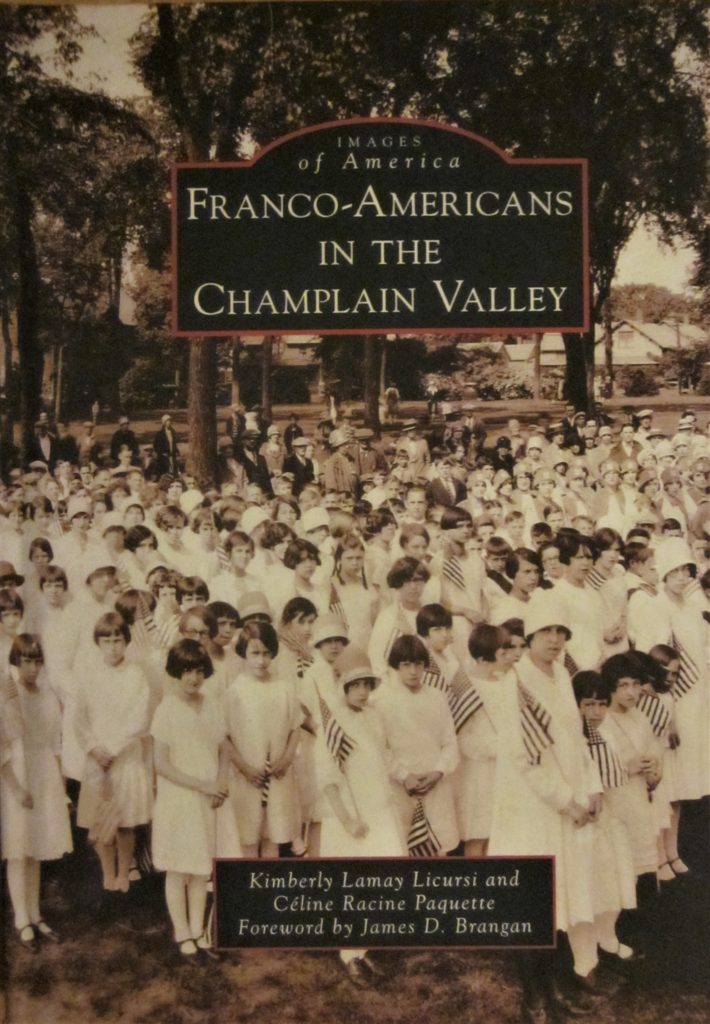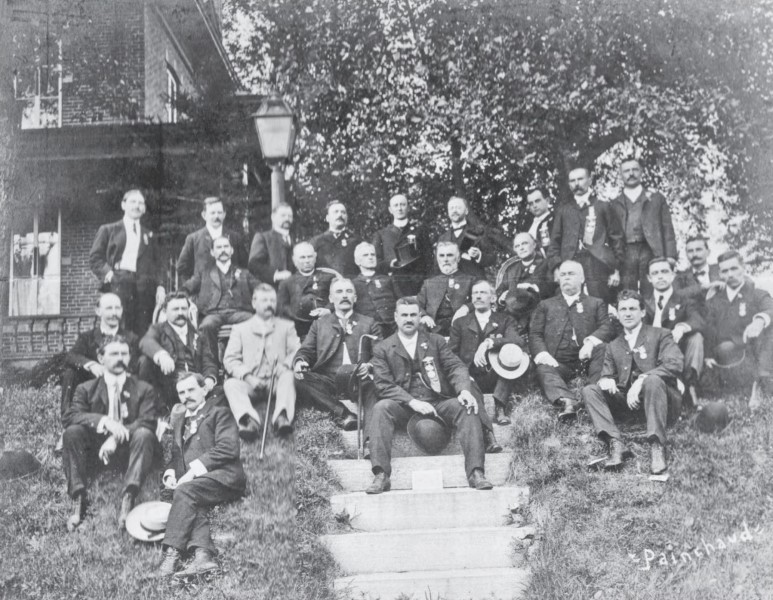Book Review
Kimberly Lamay Licursi and Céline Racine Paquette. Franco-Americans in the Champlain Valley. Images of America. Charleston: Arcadia, 2018.
The nearly seven years I spent in the United States were as enriching outside of the classroom as in—and, mind you, I was there to study and teach. From one academic environment to the next, I had the pleasure of studying Franco-Americans… and peddling a dissertation on New Englander hors pair, John F. Kennedy. The prevalence of French names in Newmarket, New Hampshire, my home for three of those years, was a reminder that Francos are everywhere—Ils sont partout!
If I spent much of my time in southern New Hampshire, my heart was elsewhere and I had the opportunity every so often to hop in the car and explore. Raised on Derek Muirden’s People Near Here and Roadside Adventures (no small inspiration), I constantly looked back and went back to the Champlain Valley. Here too, in a more familiar landscape, was a substantial Franco-American population. But, throughout their history, the French Canadians of upstate New York and Vermont have found few voices to share their story and make a case for their significance past and present.
That is changing. We have people to follow Peter Woolfson and J.-André Sénécal and to put this understudied ethnic group on the map again. The French Connections conference, held in Burlington in 2017, was a landmark event. I have written blog posts and several scholarly articles (see here and here, for instance), but many researchers have done far more for far longer. Among them are Kimberly Lamay Licursi and Céline Racine Paquette, authors of Franco-Americans in the Champlain Valley (2018), which we should hail as a major advance in regard to visibility.
Licursi, a historian and college instructor, and Paquette, the founder and curator of the Champlain History Center in Champlain, N.Y., put together a wonderful work based on local photographic collections. In five chapters detailing the lives of Champlain Valley Francos—with special focus on Winooski—they provide a sense of their subjects’ parochial and cultural activities; we also find, more casually, people in their daily lives and circumstances.

This work comes from Arcadia, which continues to spur interest in local history. The History Press, which Arcadia purchased several years ago, brought us Dyke Hendrickson’s Franco-Americans of Maine (2010), Robert Perreault’s Franco-American Life and Culture in Manchester, New Hampshire (2010), Mary Rice DeFosse and James Myall’s Franco-Americans of Lewiston–Auburn (2015), and other community studies that place heavy emphasis on French-Canadian immigrants and their descendants. Licursi and Paquette’s contribution to this important series is perhaps more groundbreaking simply by virtue of its subject matter.
This is not to deny the originality or quality of the other works mentioned here; people of French-Canadian descent in Vermont and New York State have simply earned far less attention in scholarly research than their counterparts in large, more easterly industrial centers.
Woonsocket, Fall River, Lowell, Manchester, and Lewiston have each made a major claim to preeminence in the landscape of Franco-America. Woonsocket, la ville la plus française d’Amérique, was home to the Union Saint-Jean-Baptiste. Fall River was, for a time, the third largest French city in North America. Lowell, seen as the geographical heart of New England Franco-Americans, served as a birthplace of the modern textile industry and the home of a favorite Franco, Jack Kerouac. At last, Manchester and Lewiston developed into the major French hubs of their respective states, with the former earning additional recognition as the seat of the ACA.
These cities have had their advocates, their spokespersons, their boosters both in cultural endeavors and in historical research. Here, they suggest, and perhaps in a handful of other cities, is where Franco-America happened. In fact one cannot read some of the landmark works in the field without concluding that Vermont and New York were backwaters, if there even were French Canadians in such remote places![1] This is particularly reminiscent of the power dynamic that inhabits Montrealers’ view of les régions in Quebec.
Though I do not want to read too much of Licursi and Paquette’s purpose in this work, we may see this as an invitation to history enthusiasts around Lake Champlain to study Franco-Americans, and to students of Franco history elsewhere to examine Vermont and New York more closely. In both cases, the outcome will be greater understanding of the full richness of American ethnic history in the Northeast.
The numbers certainly bear the authors’ case. “By the 1930s,” they write, “up to 40 percent of the population of Burlington, Vermont’s largest city, was Franco-American. Even in 1970, as immigrants became more fully assimilated, fully 13 percent of the state’s population still listed French as its native language in the US Census . . . In the 1990 US Census, people who identified as French Canadians still made up the largest ethnic group in Clinton County [N.Y.].”
Their larger body of evidence is equally compelling. Licursi and Paquette draw our attention to prominent Plattsburgh residents Dr. Joseph LaRoque and mayor Leander Bouyea; the first female lawyer in Vermont, Jessie LaFountain Bigwood; and “purportedly the first licensed female steamboat pilot in the world,” Philomena Ostiguy dit Domingue.

As for the supposed isolation of Champlain Valley Franco-Americans, through their stunning visual material the authors draw connections to Quebec as well as more populous parts of New England. One of the most remarkable images features local and regional elites gathered at the USJB congress of 1903. There we have Félix Gatineau, Adélard Archambault, and the Bouchers of Woonsocket, as well as future Vermont gubernatorial candidate Emile Blais; Dr. J. D. Bachand of St. Johnsbury and businessman Louis P. Aubin of Newport.
At last, to restate the obvious, Licursi and Paquette avoid sectioning off New York from New England, unlike the many scholars who have drawn an artificial line through the middle of Lake Champlain.
The book as a whole—as with other publications in the series—serves as a great reminder of how much academics owe to the efforts and findings of local archivists and local historians. They, more than anyone, are essential to the preservation and dissemination of our past—and we can hope that they will continue to attract the interest (and yes, the financial support) of their communities. In addition, academics need to pay more attention to local history endeavors, which, in a region of the world to which I am especially attached, are perhaps best exemplified by Vermont’s Northland Journal, edited by Scott Wheeler.
Academic or not, anyone with even a remote interest in the subject, should go for a stroll. Explore St. J.; walk around Barre and Rutland; take in the Rouses Point waterfront; imagine the Chazy of yesterday by visiting the town today; study archeological remains in Whitehall. Stop a moment to gaze and listen. It is no substitute for Licursi and Paquette’s stunning work, but I can think of no better complement.
[1] Connecticut, meanwhile, is just outright forgotten, minus the grudging admission that the state is part of New England and therefore must have had a Franco population.
Thank you, Patrick. I appreciate your mentioning that NY is totally forgotten when Franco- Americans are discussed. I’ve often said that in NY it’s like we never existed!.. That is why I have established a fairly large collection of Franco-American literature in the Samuel de Champlain History Center. I believe it is the only one in NYS.
It’s regrettable that more researchers have not looked beyond New England; the history of French Canadians in New York is rich, extensive, and multifaceted – but I am preaching to the choir. Bravo on your great work in Champlain. I’ve driven the west side of the lake a number of times – a wonderful area. When I make the trip again, this summer, I’ll be sure to drop by the Center.